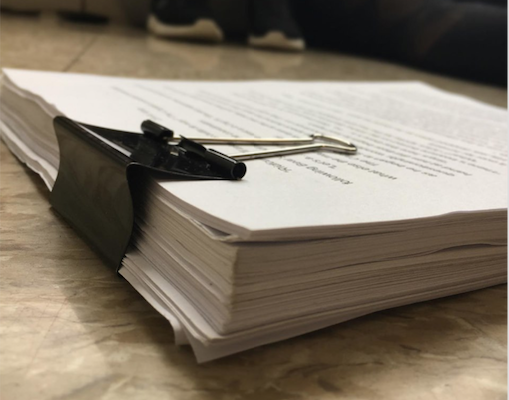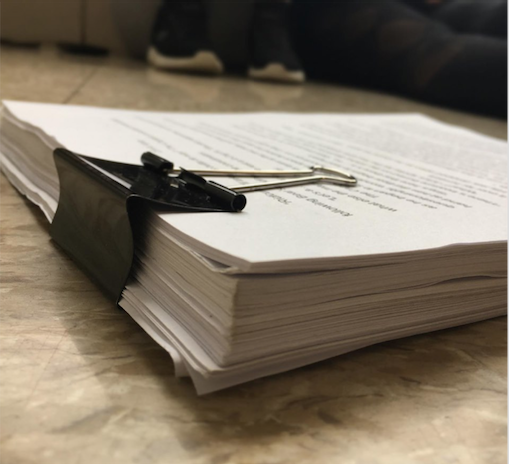The Write Stuff | Path to effective writing begins with effective habits

Skylar Promer Photo

Skylar Promer Photo
It’s no secret that writing can be a struggle. When you’re busy with other things or just plain lacking motivation, writing seems almost impossible. But no matter what you’re into or what you’re doing, whether it be writing or painting or singing, these tricks, tips and reminders will help to bring you out of your block, turning you back into a motivated artist once more.
- Switch up your music. Writing or painting or singing is always fun when it comes with a soundtrack in the background. Music helps ideas flow and connect the moment or the piece to something more. Listening to the same few songs over and over again can sometimes be necessary to provoke ideas, to move along thoughts, but sometimes listening to the same thing over and over again can become a block. Try to switch it up every once in awhile. You like listening to jazz? Try switching it up with something completely different, like classic rock or alternative. Like listening to alternative? Try classical. Maybe words aren’t helping as you try to come up with some of your own, try something that had no words. Pick some type of calming or energizing background music. With plenty of tracks to choose from on youtube, this part should be a cinch.
- Keep arting! No one said being an artist was easy, but no matter what type of artist you are, you need to keep doing what you do. People say practice makes perfect, but really, practice makes persistence. You need to have persistence in whatever art form you chose in order to progress and succeed. That means, spend at least five minutes of your day thinking of ideas. Spend just a bit of that time to write down those ideas, jot them down in a notebook somewhere, make it work. If you’re a writer, try to take the time to write at least one sentence a day. It may not look like much now, but it will really make a difference later on. This will help ideas to flow, helping you to move on with your story one sentence at a time.
- Don’t fix mistakes. Well, at least not immediately. One problem many people have that causes their block is when they go back and try to fix things when their story isn’t finished yet. Of course there are going to be tons of mistakes, and you are going to want to go and fix them the moment you see them. When you do this, often times you will spend more time fixing things than actually finishing your story. Save this task for the end. Instead, try leaving a note at the place where you think there is a problem and come back to it when the story is finished. When the story is finished, you will know more about yourself as a writer and the characters, plot and storyline themselves, and this will make it easier to come back and fix and add things. Sure, allow yourself to add something here and there, but don’t go into full editing mode before the whole thing is finished. Doing so can discourage you. Fix your habits. Don’t edit until the end.
- Share with a friend. Sharing your art can be scary. There’s always the fear of rejection and criticizing of your piece. This part is tricky, but once you find the right person to share your work with, even if it’s just a short bit, you will find a new confidence in yourself that will help bring your art to life. You just have to find the right person. Try sharing your work with a close friend that you would have little to no problem with dealing with criticism. Though it can be scary, constructive criticism is something all artists must face. It is your job to let the person know what kind of criticism you’re looking for. If you just need some encouragement, tell them this. It does not make you any less of an artist if you just want to hear good things about the early work of a piece. Though at some point you must come to terms and learn to face the bad criticisms too, but you can wait until the editing period for this. Build yourself up during the work in progress, and then work your way to the harsher criticisms. You will thank yourself for it.
- Take breaks. Now, breaks can mean many things. One thing you do not want to do unless absolutely necessary is going on a hiatus. A hiatus is a long break where artists of all kinds spend their time away from the art, not working on it or even thinking about it for extended periods of time. A hiatus is not what you want to do. Instead, take smaller, shorter breaks every now and then. Don’t completely walk away from the piece; simply try seeing it from a new angle. Taking a break can mean allowing yourself a snack while you look over it or taking a bathroom break that almost all artists know they’ve been holding for way too long. Take the break for as long as you need, be it to rest, to sleep, to or to refuel. Just promise yourself that you will always come back to it within the next hour, within the next day if it gets to that, but do not abandon it. It may look small right now. It may look weak, but just give it a little heart and a little tweak and soon you’ll be flying.
- Art takes time! You just need to remember that these things take time. Nothing happens overnight, many people say that, but it’s true. All you need to do is keep working at it one day at a time. The only thing holding you back is yourself. If you just allow yourself a little bit of time each day, you will find your piece growing and changing a little bit more each time. You just need to remember to give yourself that time, be it five minutes or an entire day dedicated to working on your art. Nothing will stop you more than yourself. Set aside five minutes at the beginning or end of the day and you will definitely start to see improvement. It just takes a bit of time.









You must be logged in to post a comment Login